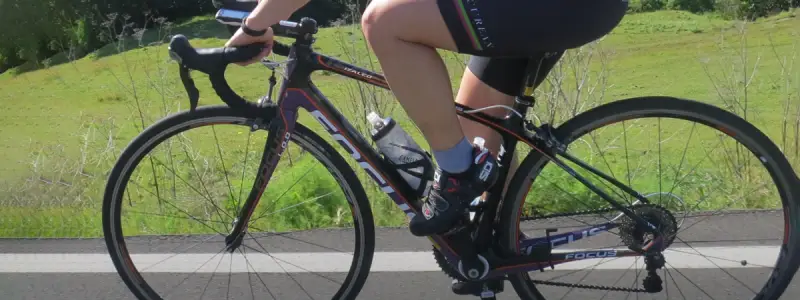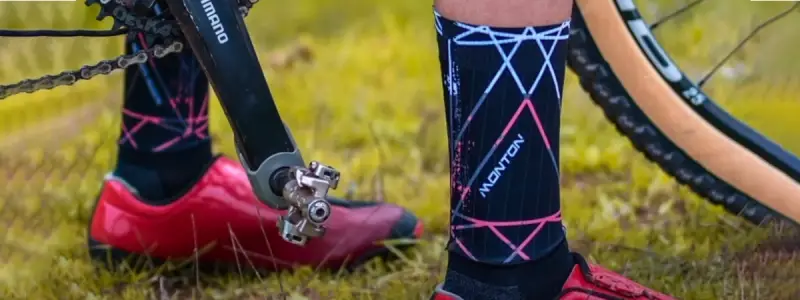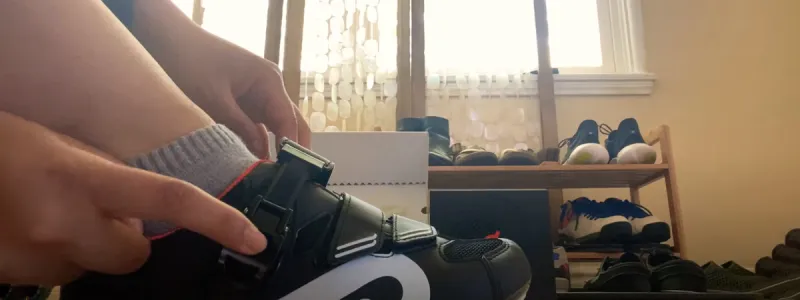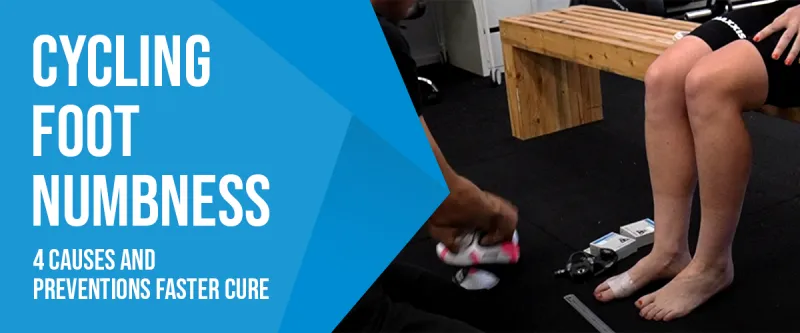Foot numbness can lead to complications like foot ulcers or sores. Fractures, sprains, and strains can damage the nerves that supply your feet. Loss of balance and coordination can contribute to foot numbness complications, which may increase the risk of falls.
Cycling foot numbness can be caused by narrow shoes and ill-fitting footwear, leading to restricted blood circulation and tingling sensations. Adding metatarsal buttons and small pads under the football can provide relief.
We will explore the causes of cycling foot numbness and some remedies and solutions for preventing and treating it.
Cycling Foot Numbness: 4 Shoe Fit Tips & 3 Cleat Fixes

Several factors can contribute to this problem, and addressing them can help to alleviate the issue. Here we’ll examine the causes and provide tips for preventing and managing it.
Shoe Fit
A comfortable and safe cycling experience requires the right shoe fit. A pair of ill-fitting shoes can cause numbness, tingling, pain, or hot spots on the feet. A breakdown of how shoe fit can affect cycling foot numbness is given below:
- Tight shoes restrict your foot expansion when riding and compress the nerves and blood vessels, resulting in numbness and reduced circulation. Friction and pressure points in tight shoes can also create discomfort and blisters.
- Your feet can move around inside too-loose shoes, resulting in friction, instability, and hot spots. The nerves can also become irritated and numb as a result.
- Shoes that are different from the correct width or shape for your foot can create gaps or pressure points that interfere with foot comfort and stability. Narrow or wide shoes can cause pain and discomfort.
- A shoe that does not fit your foot arch height may cause your foot to collapse or overextend, resulting in pain, numbness, or discomfort.
Cycling Shoe Size, Width, and Shape Tips:
Choosing the right cycling shoes can significantly affect your foot comfort and performance. Here are some tips to help you choose the best cycling shoes for your needs:
- Measure your feet before buying cycling shoes: Take measurements of your foot length, width, and arch height to find the right fit. Remember to measure both feet, as they may differ in size.
- Choose cycling shoes slightly larger than your measured foot size: Leave about a thumb’s space between your longest toe and the shoe to allow for swelling and movement.
- Choose cycling shoes that match your foot width: Most cycling shoes come in standard widths, but some brands offer wide or narrow options. Check the letter after the size number to find the right fit.
- Choose cycling shoes that support your foot arch: Depending on your foot arch height, you may need more or less arch support in your cycling shoes. Check your foot arch with the wet test or an arch index for the proper support.
Cleat Position
A cleat secures your shoes to the pedals and facilitates efficient pedaling. Correctly positioned cleats can restrict blood flow, create pressure points, and irritate nerves in your feet, resulting in numbness, tingling, or pain.
Interestingly, diabetes stands as the primary contributor to neuropathy, with half of diabetic individuals experiencing foot numbness and pain due to this condition.
Fore/aft position refers to how far forward or backward the cleat is placed on the shoe. Cleats should be positioned so that the pedal axis aligns with the ball of the foot or the metatarsal head.
You can transfer power to your bike from your legs in this position. Cyclists commonly face numbness in the ball of the foot due to pressure concentration in this region during pedaling.
If you have a large shoe size or a high arch, placing your cleat slightly behind the ball of your foot is more comfortable. By placing the cleat behind the ball of the foot, you can avoid nerve compression, resulting in numbness and pain in the area.
Foot Anatomy and Pedaling Styles: Cleat Position Adjustment
Here are step-by-step guidelines to help you adjust your cleat position based on your foot anatomy and pedaling style to enhance comfort and reduce cycling foot numbness.
- Put a marker on the side of your shoe and mark the first and fifth metatarsal heads. Mark these bumps behind your toes with tape or stickers on the inside and outside of your foot.
- You should draw a line across your shoe’s sole between the two marks. You can use this line to determine where your foot’s ball is located.
- Move your shoe until the center of its axis aligns with the line connecting the two marks. The bolts on your cleat can be loosened and slid forward or backward to align it.
- You can test your cleat position by riding your bike briefly. You can adjust the cleat position slightly by moving it forward or backward if you experience numbness, discomfort, or pain.
- Repeat the above process for the other shoe, ensuring that both cleats are symmetrical and aligned with the ball of your foot.
Socks

A pair of socks that don’t fit correctly and is worn improperly can result in numbness and tingling sensations in your feet. Here are some ways socks can contribute to cycling foot numbness:
- Tight Socks: Tight socks can constrict blood circulation and compress nerves in your feet, causing discomfort and numbness.
- Loose Socks: When your socks are too loose, they can bunch up in your shoes and cause pressure points, especially if worn with cleat bolt holes.
- Thick Socks: Thick socks reduce the space for your feet to expand, especially on long or hot rides when they swell, causing foot numbness.
- Thin Socks: Too-thin Socks can cause friction and chafing on your skin, which can irritate nerves and cause pain or numbness.
- Poor Quality Socks: Socks of inferior quality materials can trap moisture, heat, and bacteria, leading to infections and inflammation in your feet.
Sock Material, Thickness, and Fit Advice
To avoid cycling foot numbness, here are some tips that can help you choose the right socks for your feet:
- Material: Choose socks made of breathable, antimicrobial, and moisture-wicking materials, such as wool, bamboo, or synthetic blends. Socks made of cotton tend to trap moisture and cause blisters.
- Thickness: Consider the season and temperature when choosing socks. Wear thicker socks that provide insulation and warmth without tightening your shoes during cold weather. Thinner socks may offer better airflow and ventilation in hot weather but may cause friction or chafing.
- Fit: Socks should fit snugly but not too tightly. You should not restrict blood flow or compress nerves but keep them from slipping around or bunching up in your shoes.
Pedaling Technique and Cadence
Pedaling technique and cadence refer to how you position your feet on the pedals and the speed at which you spin your pedals. Pressure and friction exerted on your feet can significantly affect the likelihood of developing foot numbness.
Incorrect pedal placement or Improper shoe fit can cause numbness in the upper foot. If you experience numbness on the underside of your foot during cycling, it may be due to the sustained pressure exerted while pedaling.
A rough and efficient pedaling technique can prevent your feet from sliding around in your shoes. When this happens, it places unnecessary stress on the feet, leading to numbness. In addition, if you pedal too slowly or quickly, you may not be distributing your weight evenly across your feet, which can also cause discomfort and numbness.
Tips for Improving Pedaling Technique
To improve your pedaling technique and reduce the risk of foot numbness, consider the following tips:
- Concentrate on even pressure: Make sure you apply even pressure across the entire length of your foot when pedaling. It will help you distribute your weight more evenly and prevent excessive force on any one part of your foot.
- Ensure proper positioning: Ensure your feet and shoes are correctly positioned on the pedals. To do this, you should focus on keeping your heels down, your toes up, and your foot stable on the pedal.
- Relax: Avoid gripping your shoes or pedals too tightly. Relax your feet and allow them to move naturally with each pedal stroke.
- Frequent position changes: Regularly change your foot position on the pedals to reduce the likelihood of developing pressure points.
- Get proper fitting: Ensure your shoes fit well and suit your cycling style.
Recommended Exercises and Drills
If you are already experiencing foot numbness or want to prevent it from occurring, there are a variety of exercises and drills that you can incorporate into your training regimen. These include:
- Foot Stretching: Before and after every ride, take some time to stretch your feet and ankles.
- Balance Routines: Incorporate balance routines into your training regimen.
- Bike Fit: Ensure your bike fits properly.
- Pedal Stroke Drills: Engage in pedaling technique drills to enhance your skills. Certain cyclists experience numbness more frequently in their left foot than the right, possibly stemming from variations in leg strength or pedal stroke technique between the two sides.
- Take a break: Stop and take a break if you feel discomfort.
Numbness in The Cycling Foot: Alternative Methods
You can prevent or alleviate foot discomfort as a cyclist by following simple remedies and solutions during and after rides. Cycling foot numbness can be treated in several ways:
During the Ride

Make sure your feet remain happy and pain-free on your bike rides. You can prevent numbness and discomfort in your feet by adjusting your shoes and switching between sitting and standing.
Loosen Your Shoes
- Numbness and pain can result from tight shoes compressing your feet’s nerves and blood vessels.
- Try loosening your shoes or wearing wider toe boxes to accommodate your foot shape and size.
Flex Your Toes
You can prevent numbness from setting in or reduce it if it has already begun when you take a break or stop at a red light by flexing your toes or doing ankle circles.
Switch Between Sitting and Standing
- The saddle can cause numbness and pain when you sit on it for long periods. Many female cyclists suffer from numbness.
- The weight and force can be distributed evenly if you alternate sitting and standing during the ride.
- You can vary the pressure points by changing the position of your foot on the pedals.
Park Up and Walk
- If you feel numbness or pain in your feet, park your bike and walk around for a few minutes.
- This can help restore blood circulation and sensation to your feet, stretch your muscles and joints, and reduce swelling.
After the Ride
After a long or intense ride, taking care of your feet is crucial. The top of your foot can often feel numb during a long bike ride. Here are some tips to alleviate soreness, reduce swelling, and improve blood flow for a faster recovery.
Elevate Your Feet
- After a long or strenuous ride, your feet may be sore, swollen, or numb.
- Try elevating your feet above your heart level for 10 to 20 minutes to reduce these symptoms, drain excess fluid, and improve blood flow.
- You can also massage your feet gently to ease tension and pain.
Ice Your Feet
- If your feet are inflamed or hot, use cold compresses to numb the pain for 15 to 20 minutes.
- Cover the ice packs with a towel or cloth to avoid frostbite or skin damage.
Use Anti-inflammatory Medication
- If your feet are still painful or swollen after icing them, take over-the-counter anti-inflammatory medication, such as ibuprofen or aspirin.
- You should consult a doctor before taking any medication, especially if you have allergies.
Conclusion
A common yet avoidable cycling foot problem can ruin long bike rides and lead to chronic pain and discomfort. A cyclist can avoid this unpleasant sensation by paying attention to shoe fit, cleat position, sock selection, proper technique, and perineal numbness. When your foot goes numb while lying down, it could be due to issues with blood flow or nerve injury.
Various products and accessories, such as cycling-specific shoes and padded shorts, can minimize cycling foot numbness and restore the joy of cycling. Do not let this annoying problem keep you from enjoying your bike ride. Now is the time to prevent cycling foot numbness.
FAQs
Is Cycling Treatment Causing Perineal Numbness?
Extended pressure on a bike seat can compress nerves in the perineum, causing numbness. It may lead to persistent numbness and even sexual dysfunction. While various studies have explored different bike seat styles, there are currently no definitive recommendations for preventing this issue.
How Do I Stop My Feet from Going Numb When Cycling?
You can prevent numb feet while cycling by using metatarsal buttons in your shoes. Ensure your shoes fit properly to avoid numbness and tingling caused by poor blood circulation.


